In TimeTrak versions 3.2 and 4.0, there are four different options for attachment storage.
This white paper will take you through the different storage options and the pros and cons of each so you can make an informed decision when choosing the correct solution for your company.
It is important to note that the maximum file size that can be uploaded to TimeTrak is 20MB. This applies to all attachment storage solutions.
TimeTrak Attachment Storage is set at a “Global” database level in the TimeTrak Administrator Console as per below:
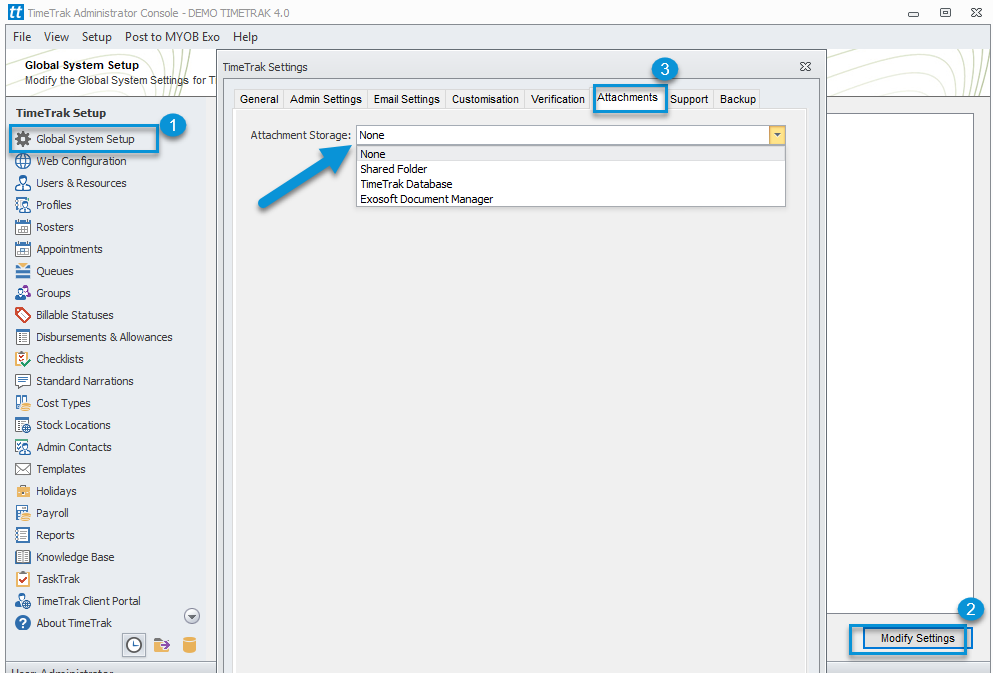
At the time of Implementation, your TimeTrak Consultant will set this up for your company.
Attachment Storage – None
If the Attachment Storage type is set to “None” in Global System Setup as per below:

No attachments (including checklists) can be loaded in TimeTrak against Jobs, Tasks or Knowledge Base articles.
If there is no attachment storage option set, the TimeTrak Outlook Add-In will not be able to be used, as this requires attachment storage to attach emails to the task.
Attachment Storage – Shared Folder
This is the preferred attachment storage method in TimeTrak if there is no requirement to browse to the folder location where the files are stored in File Explorer.
A single shared folder will need to be created on your network in a location specified by your IT Company.
Note: The size of this folder will grow depending on the amount of attachments you are going to use.
Once this folder has been created, it will need to be mapped in the TimeTrak Administrator Console under Global Settings as the TimeTrak database storage location:

Credentials that TimeTrak will use to access the file location when adding/ editing attachments are also required to be added here as per below.
These credentials require read/ write access to the shared folder.
There is the option to check credentials in the TimeTrak Administrator Console as per below to ensure that these credentials have the correct access.
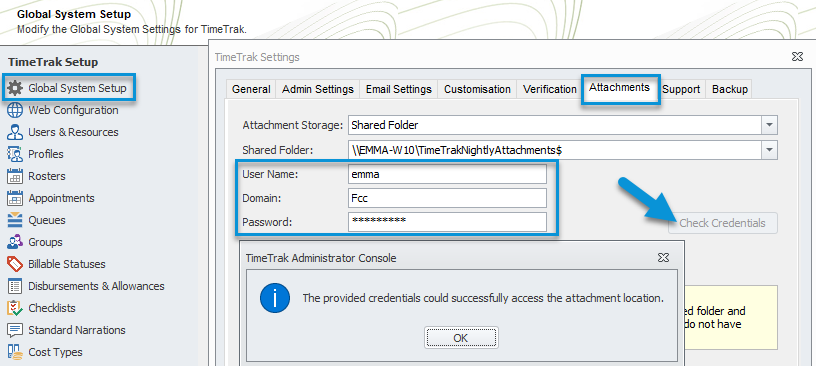
Note: It is recommended that a username and password that does not change is entered in here or users will be unable to add attachments (including submitting checklists) until the details are updated in the TimeTrak Administrator Console if the accounts password was to change.
Some IT Companies provide a “services” username and password that will not change to prevent this issue from occurring.
When using the shared folder storage type, all attachments will be stored in the specified folder and managed by TimeTrak.
It is recommended that you use a hidden share that end users do not have access to.
The folder structure is able to be browsed via File Explorer but it contains folders with no naming convention as per below example:
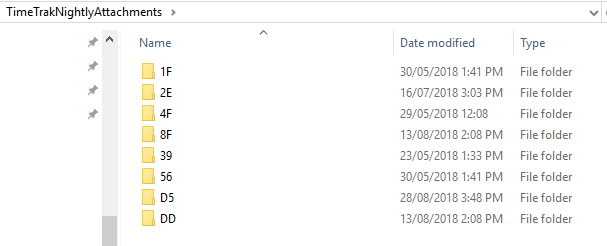
If end users have access to this file location and modify or alter attachments, TimeTrak will be unable to access the attachment and the below “Attachment source could not be found” error will occur when trying to review the attachment in TimeTrak.
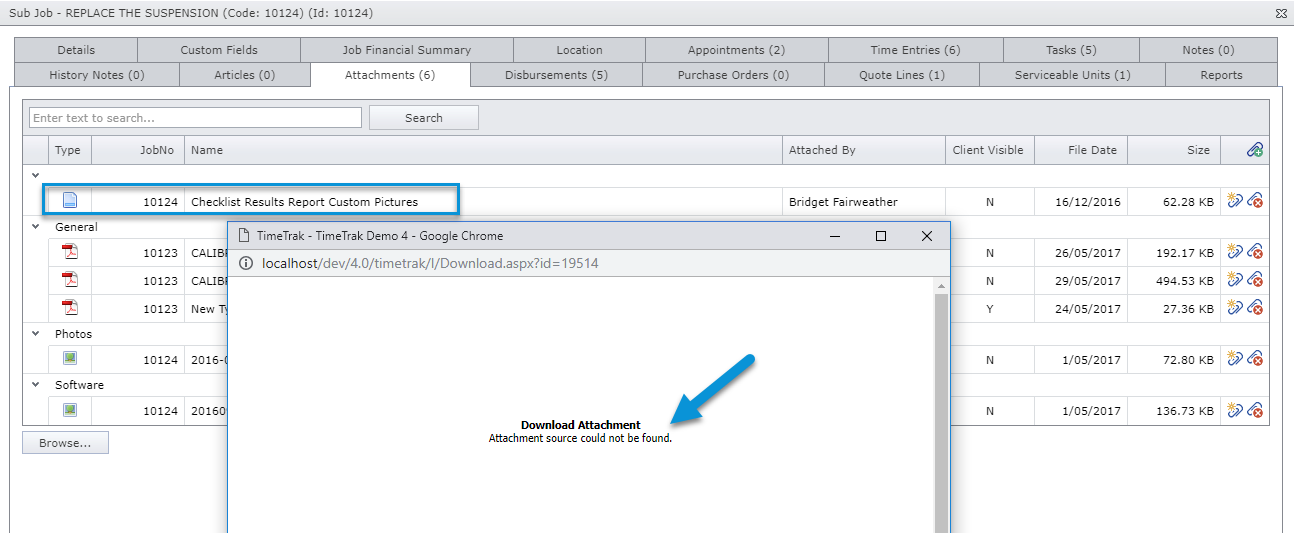
The TimeTrak 4.0 attachment database schema can be found on our website via this link.
Link Attachments to MYOB Exo Documents
TimeTrak has the option to Link Attachments to MYOB Exo Documents.
This is a global database setting and defined in the TimeTrak Administrator Console under Global System Setup as per below:
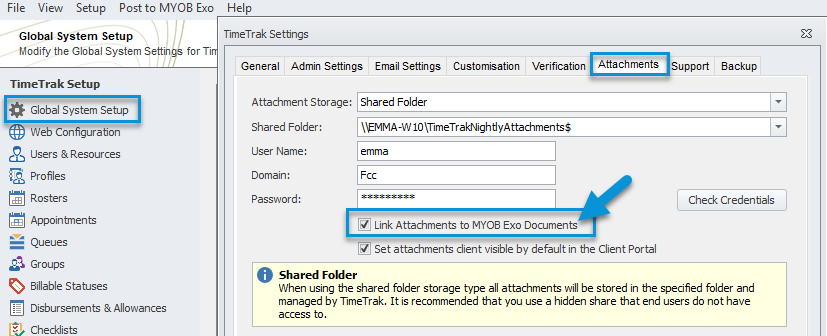
If this setting is enabled when an attachment is created in TimeTrak, a link to this attachment will also be available on the Documents tab in Exo against the Client, Job, Serviceable Unit, Purchase Order, Prospect or Opportunity (depending on where the attachment was added).
In the below example, this Demo database has this setting enabled.
Against Job 11155 there are three attachments as per below:

Against the same job (11155) in Job Costing on the Documents tab, the same attachments are available for users to view by simply double clicking on them.
The last attachment “File uploaded from checklist” is a file that was added with in one of the checklists; e.g. a photo that was uploaded.

Exo looks at the file path in which TimeTrak has stored the attachment to open this document, in the below example this is: \\EMMA-W10\TimeTrakNightlyAttachments$\2E\42\

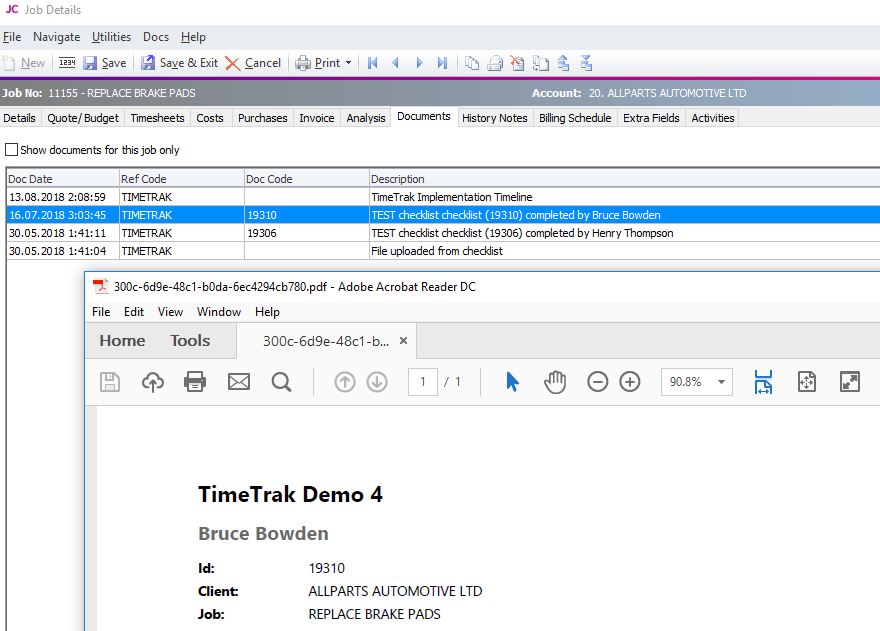
Set attachments client visible by default in the Client Portal
TimeTrak has the option to set all attachments added to be visible by default in the Client Portal.
This is a global database setting and defined in the TimeTrak Administrator Console under Global System Setup as per below and only applies if you have the Client Portal enabled.

If this setting is enabled when an attachment is created, by default, Client Portal visible will be ticked on as per below:
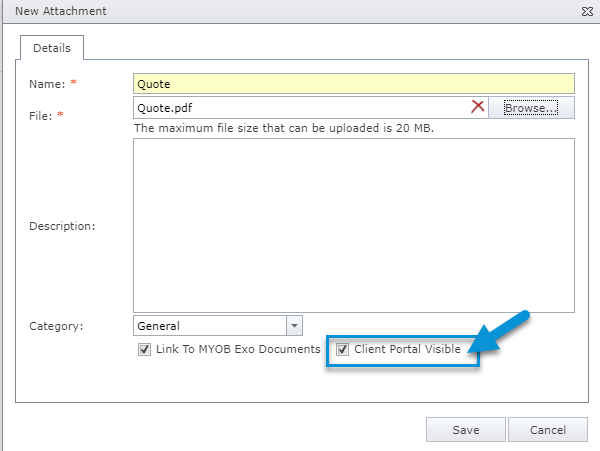

When your client logs in to your Client Portal, against the task they will be able to see any attachments that have the Client Portal Visible setting enabled against them as per below:

Attachment Storage – Exosoft Document Manager
This is the storage method that was used previously in all old implementations of TimeTrak.
This storage method requires an additional piece of software (Exosoft Document Manager) to be installed.
A shared folder will need to be created on your network in a location specified by your IT Company.
This folder is usually shared so everyone can access it and in many cases it becomes its own mapped drive.
Document Manager is setup with a connection to the Exo database (some customisation is added to the Exo database to allow this).
Once this folder has been created, it will need to be mapped in the TimeTrak Administrator Console under Global Settings as the TimeTrak database storage location:

Credentials that TimeTrak will use to access the file location when adding/ editing attachments are also required to be added here, as per below.
There is the option to check credentials in the TimeTrak Administrator Console, as per below, to ensure that these credentials have the correct access.
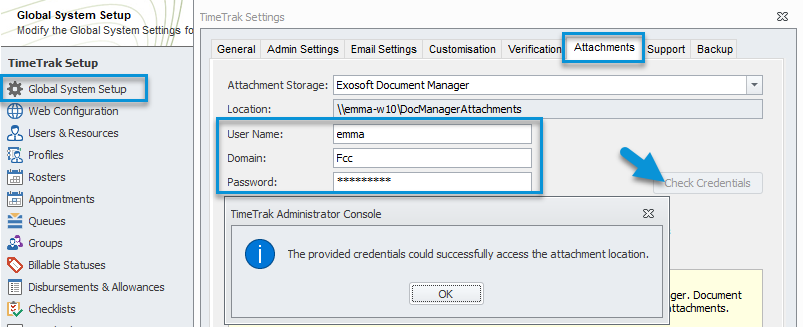
Note: It is recommended that a username and passwOrd that does not change is entered in here or users will be unable to add attachments (including submitting checklists) until the details are updated in the TimeTrak Administrator Console if the accounts password was to change.
Some IT Companies provide a “services” username and password that will not change to prevent this issue from occurring.
When using the Document Manager storage type, some configuration will be required in the Exosoft Document Manager Application also.
Integration to the TimeTrak database will need to be enabled to allow TimeTrak attachments to save to the structured file location.
The folder structure will need to be configured as per below example:
Note the field tags are limited to below:
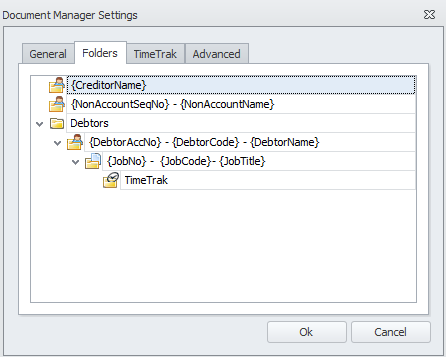
You will need to enter a DatabaseId and set your Synchronisation schedule for after the initial synchronisation has run.
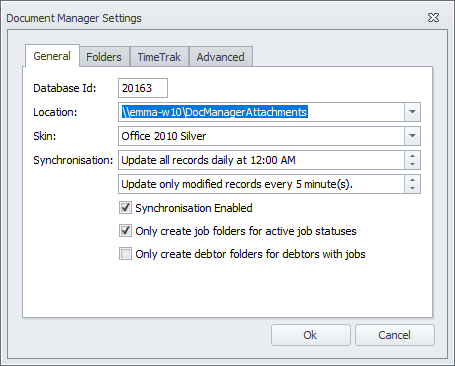
It is important to note that Document Manager runs on a Windows service and creates a hidden share for every Non-Account, Creditor, Debtor and Job that a folder is created for.
The amount of hidden shares that Document Manager generates does not interact with modern servers as efficiently as it used to, which is why shared folder is often the preferred attachment method.
In the above example, the service is only going to run every five minutes. This will limit the ability to create a Job and add attachments against it straight away as the service will not have run and created the hidden share which will prevent the ability to add attachments and users will receive the below error:
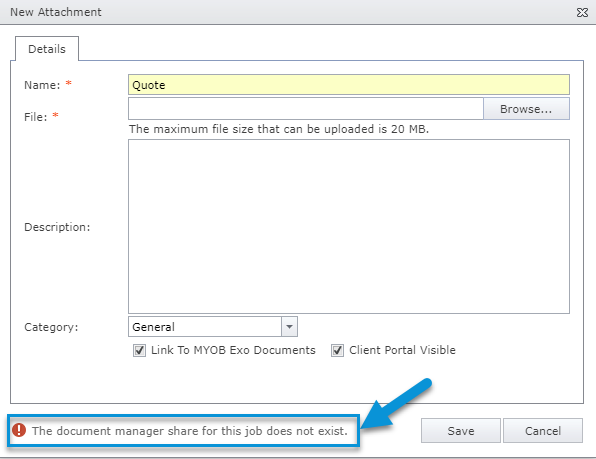
Once the Document Manager Service has run and the hidden share has been created, you will be able to attach documents to the Job/ Client/ Task/ Prospect etc.
In this example, the attachment has been added against the Job in TimeTrak as per below:

Users can go to the Document Manager share to browse for the attachment:
Debtors > Select the Debtor account > Select the Job > TimeTrak > Job

Document Manager has set the folder as a hidden share, as per below, with the company’s database Id (in this case 20163) also passed into the hidden share name as per below:
\\EMMA-W10\XS_Job20163_12163$\TimeTrak\Job
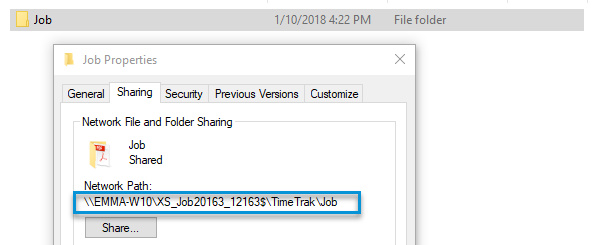
Link Attachments to MYOB Exo Documents
TimeTrak has the option to Link Attachments to MYOB Exo Documents.
This is a global database setting and defined in the TimeTrak Administrator Console under Global System Setup as per below:
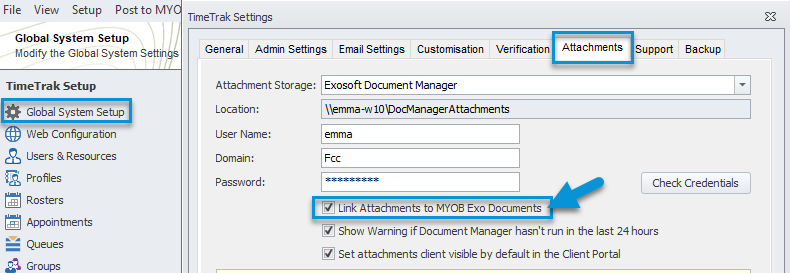
Please refer to Link Attachments to MYOB Exo Documents Attachment Storage – Shared folder for more information.
Set attachments client visible by default in the Client Portal
TimeTrak has the option to set all attachments added to be visible by default in the Client Portal.
This is a global database setting and defined in the TimeTrak Administrator Console under Global System Setup as per below and only applies if you have the Client Portal enabled.
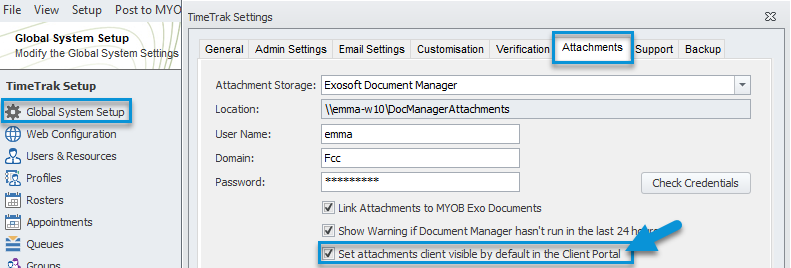
Please refer to Link Attachments to MYOB Exo Documents Attachment Storage – Shared folder for more information.
Show Warning if Document Manager hasn’t run in the last 24 hours
Due to Document Manager running via a service, on top of the standard attachment options that are mentioned above and available across all attachment storage options, if Document Manager is specified as the Attachment Storage option then the setting “Show Warning if Document Manager hasn’t been run in the last 24 hours” will be available.
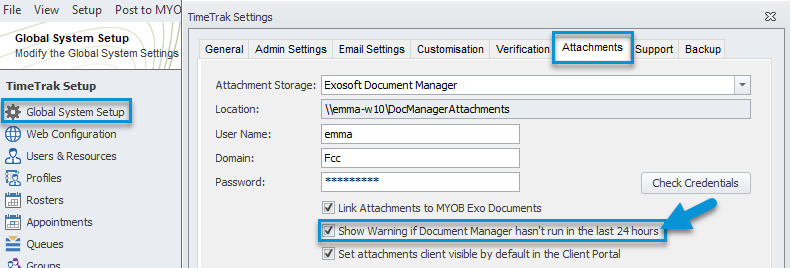
If this setting is enabled and Document Manager has not run in the last 24 hours, within the TimeTrak Professional website the below pop up message will appear.
This message is to prompt end users who contact the TimeTrak support team to investigate why the service has stopped running and start the service again to provide the ability for attachments to be saved in TimeTrak.

Users who have access to the TimeTrak Administrator Console can see the last time that document did run in the below location:
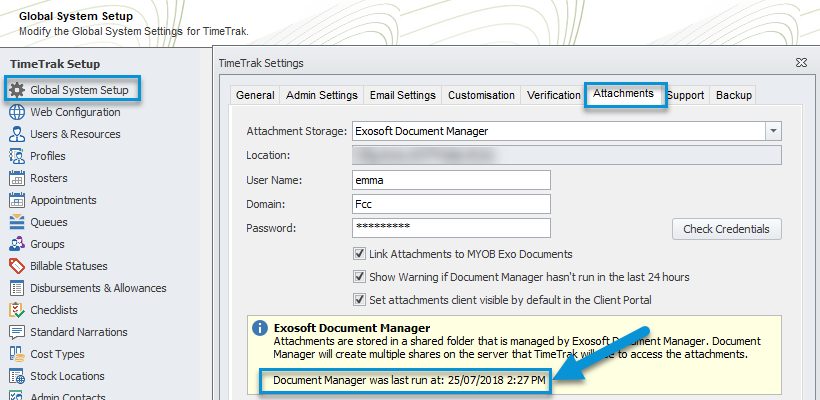
Attachment Storage – TimeTrak Database
This Storage method does not have a separate file location, as files are stored directly in the TimeTrak database.
This is the least common attachment storage option, and not recommended due to the impact that it can have on the TimeTrak database if a lot of attachments are going to be used.
The more attachments that are added, the larger the database will be come, meaning the size of backups and room that is required to store these on your server will also increase over time.
Like all other attachment types, this will need to be defined in the TimeTrak Administrator Console under Global System Setup as per below:

Once defined in Global Settings, attachments can be added in both Professional and Mobile websites.
Unlike the attachment storage types Document Manager and Shared folder, the TimeTrak database storage type does not have the option to link attachments to MYOB Exo Documents.
Set attachments client visible by default in the Client Portal
TimeTrak has the option to set all attachments added to be visible by default in the Client Portal.
This is a global database setting and defined in the TimeTrak Administrator Console under Global System Setup as per below and only applies if you have the Client Portal enabled.

Please refer to Link Attachments to MYOB Exo Documents Attachment Storage – Shared folder for more information.
Download Whitepaper – PDF